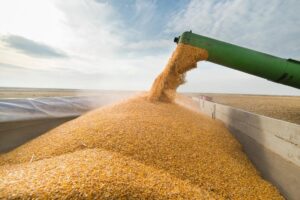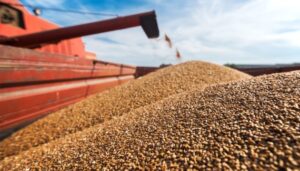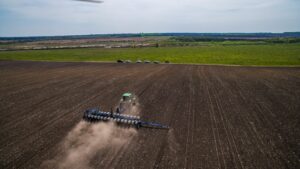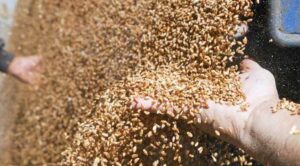
The Ukrainian Grain Association (UGA) has lowered its estimate of the potential harvest of grains and oilseeds in 2024 by 2.8 million tons compared to the previous forecast, to 71.8 million tons, the association’s press service reports.
“The current forecast is based on the average weather conditions over the past five years, so the improvement or deterioration of these conditions in spring and summer make adjustments. Another decrease in the harvest forecast for the new season was caused by the hot and dry weather in Ukraine in July this year, which negatively affected the potential yield of late grains and oilseeds,” the report says.
According to experts, under such conditions, exports in the new season 2024/2025 will amount to 41 mln tons, which is 2.5 mln tons less than the previous forecast. Last season, which ended on June 30, according to the UGA, the export of grains and oilseeds amounted to 57.5 mln tons of grains and oilseeds. Thus, the drop in exports compared to the previous season could be more than 16 million tons.
The UGA estimates the wheat harvest in 2024 at 19.8 mln tons (22 mln tons in 2023). Potential exports of wheat in 2024/2025 MY may amount to about 13 mln tonnes, taking into account that at the beginning of the season carry-over stocks amounted to almost 1 mln tonnes.
The UGA pointed out that the consumption of wheat in Ukraine has decreased due to the war and significant outflow of population abroad. According to the Ministry of Agrarian Policy of Ukraine, wheat consumption decreased from 8 mln tons to just over 6 mln tons.
According to the UGA, the barley harvest in 2024 may reach 4.95 mln tonnes, which is 350 thsd tonnes more than the previous estimate (5.8 mln tonnes in 2023), and potential exports in 2024/2025 MY are expected to reach about 2 mln tonnes (last year barley exports amounted to almost 2.5 mln tonnes).
Expectations for the corn harvest in the new season are deteriorating due to the prolonged dry period in a number of regions. The UGA estimates the corn harvest at 23.4 million tons, which is 2.1 million tons lower than the previous estimate and 6.2 million tons less than last year’s harvest of 29.6 million tons. At the same time, potential exports may amount to about 18.5 mln tons (last season, exports amounted to 29.3 mln tons, in particular due to carry-over corn stocks).
The sunflower harvest in 2024 can be expected at 12.8 mln tons, which is 0.9 mln tons lower than the previous estimate (2023 – 14.2 mln tons). Potential exports could reach up to 250 thsd tonnes, while sunflower crushing for vegetable oil could reach 12.5 mln tonnes. Last season, the processing amounted to 13.5 mln tons.
In 2024, the UGA expects the rapeseed harvest to reach 4.3 mln tonnes (4.5 mln tonnes in 2023), while the exports in 2024/2025 MY will be 3.4 mln tonnes (3.7 mln tonnes in the current season).
As for soybeans, despite the fact that farmers have increased the area under the crop, unfavorable weather conditions will not allow to get a bigger harvest due to lower yields, experts believe. According to their estimates, the soybean harvest can be expected in 2024 at 4.8 mln tonnes, which is 0.7 mln tonnes less than the previous estimate (4.9 mln tonnes in 2023). Potential exports in 2024/2025 MY may reach 3.5 mln tonnes (last season – almost 3 mln tonnes).
As reported, in 2023, the UGA estimated the harvest at 82.8 mln tons of grains and oilseeds.

Ukraine in the 2023-2024 marketing year, ending June 30, 2024, exported 57.5 million tons of grains and oilseeds from a harvest of 82.8 million tons, with transitional stocks of about 7 million tons, the Ukrainian Grain Association (UGA) said.
“Last season, the most important factor for Ukrainian grain exports was the opening of the Ukrainian Humanitarian Corridor, which allowed exports by sea from the deep-water ports of Odessa. The second most important factor was the introduction by Ukraine together with international partners of a working mechanism of insurance of ships entering Ukrainian ports, which reduced the cost of exporters and, accordingly, Ukrainian agricultural producers on export logistics”, – said the association.
According to UZA analysts with reference to the information of the State Customs Service, in monetary terms exports of grains and oilseeds in 2023/2024 MY amounted to $10.76 billion, and exports including products from them, including sunflower oil and other oils, cakes and meal, amounted to $17.86 billion.
Wheat exports totaled 18.4 million tons worth $3 billion, with production of about 22 million tons. The top 3 importing countries of Ukrainian wheat included Spain, which purchased 5.899 million tons, Egypt – 1.721 million tons, Indonesia – 1.515 million tons.
Barley Ukraine supplied abroad almost 2.5 million tons for $376 million, with production of 5.8 million tons. The most active buyers were China – 702 thousand tons, Indonesia – 460 thousand tons, Cyprus – 221 thousand tons.
Last season Ukraine exported 29.3 million tons of corn worth $4.7 billion, while last year’s production was 29.6 million tons. Its main buyers were Spain – 6.011 million tons, China – 4.832 million tons, Egypt – 3.874 million tons.
Nearly 3 million tons of soybeans were sold to other countries for the amount of $1.1 billion, with a harvest of 4.9 million tons. The top 3 buyers were Egypt – 956 thousand tons, Turkey – 674 thousand tons, Germany – 235 thousand tons.

Ukraine exported 57.5 mln tonnes of grains and oilseeds in 2023-2024 marketing year, which ended on June 30, 2024, out of the harvest of 82.8 mln tonnes, while the carry-over stocks amounted to about 7 mln tonnes, the Ukrainian Grain Association (UGA) reported.
“Last season, the most important factor for the export of Ukrainian grain was the opening of the Ukrainian Humanitarian Corridor, which allowed exports by sea from the deep-water ports of Odesa region. The second most important factor was the introduction by Ukraine, together with international partners, of a working mechanism for insuring ships entering Ukrainian ports, which reduced the costs of exporters and, accordingly, Ukrainian agricultural producers for export logistics,” the association noted.
According to the UGA analysts, referring to the information of the State Customs Service, in monetary terms, the exports of grains and oilseeds in 2023/2024 MY amounted to $10.76 bln, and exports including products from them, including sunflower oil and other oils, cake and meal – $17.86 bln.
Wheat exports amounted to 18.4 million tons worth $3 billion, with production of about 22 million tons. The top 3 importing countries of Ukrainian wheat were Spain, which purchased 5.899 mln tons, Egypt – 1.721 mln tons, and Indonesia – 1.515 mln tons.
Ukraine exported almost 2.5 mln tons of barley for $376 mln, against the production of 5.8 mln tons. The most active buyers were China – 702 thousand tons, Indonesia – 460 thousand tons, and Cyprus – 221 thousand tons.
Last season, Ukraine exported 29.3 mln tons of corn worth $4.7 bln, compared to last year’s production of 29.6 mln tons. Its main buyers were Spain – 6.011 million tons, China – 4.832 million tons, and Egypt – 3.874 million tons.
Almost 3 mln tons of soybeans were sold to other countries for $1.1 bln, with a harvest of 4.9 mln tons. The top 3 buyers were Egypt – 956 thsd tonnes, Turkey – 674 thsd tonnes, and Germany – 235 thsd tonnes.
Ukraine exported 3.7 mln tons of rapeseed worth $1.4 bln, compared to last year’s production of 4.5 mln tons. The most active buyers were Germany – 1.226 mln tons, Romania – 609 thsd tonnes, and the Netherlands – 420 thsd tonnes.

Ukrainian agrarians have completed the spring sowing season, during which 7.2 million hectares were sown with oilseeds, and about 5.6 million hectares with cereals and legumes, which is 22.6% above the forecast, the press service of the Ministry of Agrarian Policy and Food reported.
According to the report, agrarians have sown more than 99% of the projected areas of spring cereals and legumes. They allocated 3.93 million hectares for corn, which amounted to 100.4% of the projected area, barley – 783 thousand hectares (95.7%), wheat – 252.7 thousand hectares (102.6%), oats – 163.7 thousand hectares (100.7%), peas – 162.5 thousand hectares (101.6%), buckwheat – 100.8 thousand hectares (80.7%), millet – 69.7 thousand hectares (81.8%).
5.19 million hectares (98%) have been allocated for sunflowers, 2.03 million hectares (102%) for soybeans.
Sugar beet is sown on 250.1 thousand hectares (97%).
As reported, the Ministry of Agrarian Policy in April forecasted the sown area of grain and leguminous crops in 2024 at the level of 10.6 million hectares, which is 395 thousand hectares lower than in 2023.
The Ministry of Agrarian Policy expects gross production of grain and oilseeds in 2024 at the level of 74 million tons, of which about 52.4 million tons – grains, 21.7 million tons – oilseeds.
Agrarians in 2024 will be able to harvest 19.2 million tons of wheat (22.2 million tons were harvested in 2023), 4.9 million tons of barley (5.7 million tons), 26.7 million tons of corn (30.5 million tons), 5.2 million tons of soybeans (4.7 million tons), 12.4 million tons of sunflower (12.9 million tons), 4.1 million tons of rapeseed (4.7 million tons).

As of May 2, Ukraine planted 3.407 million hectares of spring grains and pulses, up 1.5 times year-on-year, the press service of the Ministry of Agrarian Policy and Food reported on Friday.
According to the report, 240.7 thousand hectares were planted with wheat (223.3 thousand hectares a week earlier), 775.7 thousand hectares with barley (761.5 thousand hectares), 161.1 thousand hectares with peas (159.2 thousand hectares), 159.9 thousand hectares with oats (146.6 thousand hectares), and 16.7 thousand hectares with millet.
Over the past week, farmers sowed 861 thsd ha of spring crops. A week earlier, the figure was 492.9 thou hectares, and 792.6 thou hectares the week before. The leaders are farmers in Sumy region, where 97.4 thou hectares were sown during the week.
According to the Ministry of Agrarian Policy, Kyiv region is the leader in terms of sowing rates, having planted 31.3 thou hectares of wheat, 43.1 thou hectares of barley, 5.8 thou hectares of peas and 6 thou hectares of oats. Dnipropetrovs’k region – 28 thou hectares of wheat, 50 thou hectares of barley, 14.17 thou hectares of peas, 1 thou hectares of oats; Ternopil region – 18.9 thou hectares of wheat, 63.6 thou hectares of barley, 3.6 thou hectares of peas and 5.1 thou hectares of oats. hectares of oats; Sumy – 18.2 thousand hectares of wheat, 17.9 thousand hectares of barley, 5.6 thousand hectares of peas and 9.8 thousand hectares of oats; Zhytomyr – 16.5 thousand hectares of wheat, 19.3 thousand hectares of barley, 3 thousand hectares of peas and 26 thousand hectares of oats. hectares of oats; Khmelnytsky – 14.8 thou hectares of wheat, 59.1 thou hectares of barley, 2.6 thou hectares of peas and 2.5 thou hectares of oats; Vinnytsia – 11.5 thou hectares of wheat, 55 thou hectares of barley, 6 thou hectares of peas and 1.1 thou hectares of oats.
In addition, sunflower was planted on 2,967.5 thou hectares, soybeans – 566.7 thou hectares, sugar beets – 248.4 thou hectares.
According to the April forecast of the Ministry of Agrarian Policy, in 2024, the gross production of grains and oilseeds in the country is expected to reach 74 mln tons, including about 52.4 mln tons of grains and 21.7 mln tons of oilseeds.
In 2024, farmers will be able to harvest 19.2 million tons of wheat (22.2 million tons in 2023), 4.9 million tons of barley (5.7 million tons), 26.7 million tons of corn (30.5 million tons), 5.2 million tons of soybeans (4.7 million tons), 12.4 million tons of sunflower (12.9 million tons), and 4.1 million tons of rapeseed (4.7 million tons).
In 2024, the planted areas of grains and pulses are forecasted at 10.6 mln ha, which is 395 thou ha lower than in 2023.

In 2023, Agrotrade harvested more than 255 thsd tonnes of grains and oilseeds, some of which showed record yields, the company’s press service reported on its Facebook page on Thursday.
“For the company, 2023 was one of the best years in terms of yields over the past five years. The harvest of corn, winter rapeseed and soybeans was particularly high. In addition, last year we switched to conventional mustard cultivation for the first time and immediately exceeded our threshing plans,” said Oleksandr Ovsyanyk, Director of the Agricultural Department, as quoted by the group’s press service.
He added that the company’s successful results were achieved, in particular, thanks to effective fertilizer and plant protection technologies, a high level of selection of varieties and hybrids, and favorable weather conditions.
According to the report, in 2023, the agricultural holding grew and harvested 84.8 thousand tons of corn, almost 70 thousand tons of wheat, 52.5 thousand tons of winter rape, 29.5 thousand tons of sunflower, 15.7 thousand tons of soybeans, 2.5 thousand tons of mustard and other crops.
As reported, in 2023, Agrotrade supplied about 350 thsd tonnes of grain to the global market. The share of own agricultural products amounted to 35% or 116 thsd tonnes, and third-party producers – 65% or 230 thsd tonnes.
The Agrotrade Group is a vertically integrated holding company with a full agro-industrial cycle (production, processing, storage and trade of agricultural products). The company cultivates over 70 thousand hectares of land in Chernihiv, Sumy, Poltava and Kharkiv regions. Its main crops are sunflower, corn, winter wheat, soybeans and rapeseed. It has its own network of elevators with a simultaneous storage capacity of 570 thousand tons.
The group also produces hybrid seeds of corn and sunflower, barley, and winter wheat. In 2014, a seed plant with a capacity of 20 thousand tons of seeds per year was built on the basis of Kolos seed farm (Kharkiv region). In 2018, Agrotrade launched its own brand Agroseeds on the market.
Vsevolod Kozhemiako is the founder and CEO of Agrotrade.